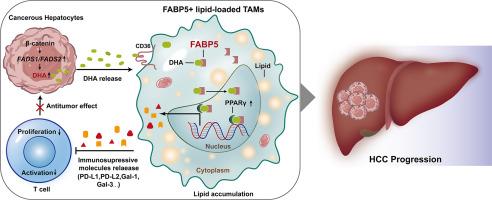FABP5+ lipid-loaded macrophages process tumour-derived unsaturated fatty acid signal to suppress T-cell antitumour immunity
IF 26.8
1区 医学
Q1 GASTROENTEROLOGY & HEPATOLOGY
引用次数: 0
Abstract
Background & Aims
Tumour-associated macrophages (TAMs) contribute to hepatocellular carcinoma (HCC) progression. However, while the pro-tumour and immunosuppressive roles of lipid-loaded macrophages are well established, the mechanisms by which lipid metabolism enhances the tumour-promoting effects of TAMs remain unclear.
Methods
Single-cell RNA sequencing was performed on mouse and human HCC tumour samples to elucidate the landscape of HCC TAMs. Macrophages were stimulated with various long-chain unsaturated fatty acids (UFAs) to assess immunosuppressive molecule expression in vitro. Additionally, in vivo and in vitro studies were conducted using mice with macrophage-specific deficiencies in fatty acid-binding protein 5 (FABP5) or peroxisome proliferator-activated receptor γ (PPARγ).
Results
Single-cell RNA sequencing identified a subpopulation of FABP5+ lipid-loaded TAMs characterized by enhanced immune checkpoint blocker ligands and immunosuppressive molecules in an oncogene-mutant HCC mouse model and human HCC tumours. Mechanistically, long-chain UFAs released by tumour cells activate PPARγ via FABP5, resulting in immunosuppressive properties in TAMs. FABP5 deficiency in macrophages decreases immunosuppressive molecule expression, enhances T cell-dependent antitumour immunity, diminishes HCC growth, and improves immunotherapy efficacy.
Conclusions
This study demonstrates that UFAs promote tumourigenesis by enhancing the immunosuppressive tumour microenvironment via FABP5-PPARγ signalling and provides a proof-of-concept for targeting this pathway to improve the efficacy of tumour immunotherapy.
Impact and implications
Despite the role of tumour-associated macrophages (TAMs) in promoting tumour progression being well established, the mechanisms by which lipid metabolism enhances the tumour-promoting effects of TAMs remain unclear. Our study reveals that FABP5-mediated unsaturated fatty acid metabolism in TAMs is crucial for modulating antitumour T-cell immunity and influencing the efficacy of immunotherapy. This finding provides novel insights into the immunomodulatory roles of FABP5+ lipid-loaded TAMs in hepatocellular carcinoma and suggests that targeting FABP5 could offer a new approach to liver cancer treatment.


FABP5+脂质负载巨噬细胞处理肿瘤衍生的不饱和脂肪酸信号,抑制T细胞抗肿瘤免疫。
背景与目的:肿瘤相关巨噬细胞(TAMs)是导致肝细胞癌(HCC)进展的因素之一。然而,虽然脂质巨噬细胞的促瘤和免疫抑制作用已得到公认,但脂质代谢增强 TAMs 促瘤作用的机制仍不清楚:方法:对小鼠和人类 HCC 肿瘤样本进行单细胞 RNA 测序,以阐明 HCC TAMs 的结构。用各种长链不饱和脂肪酸(UFAs)刺激巨噬细胞,以评估体外免疫抑制分子的表达。此外,还利用巨噬细胞特异性缺乏脂肪酸结合蛋白5(FABP5)或过氧化物酶体增殖激活受体(PPAR)的小鼠进行了体内和体外研究:结果:单细胞RNA测序发现,在癌基因突变的HCC小鼠模型和人类HCC肿瘤中,FABP5+脂质负载的TAMs亚群具有增强免疫检查点阻断配体和免疫抑制分子的特征。从机理上讲,肿瘤细胞释放的长链 UFAs 可通过 FABP5 激活 PPAR,从而产生 TAM 免疫抑制特性。巨噬细胞中 FABP5 的缺乏会降低免疫抑制分子的表达,增强 T 细胞依赖性抗肿瘤免疫,减少 HCC 的生长,提高免疫疗法的疗效:这项研究表明,UFAs 可通过 FABP5-PPAR 信号增强肿瘤微环境的免疫抑制作用,从而促进肿瘤发生,并为靶向这一途径改善肿瘤免疫疗法提供了概念验证。
本文章由计算机程序翻译,如有差异,请以英文原文为准。
求助全文
约1分钟内获得全文
求助全文
来源期刊

Journal of Hepatology
医学-胃肠肝病学
CiteScore
46.10
自引率
4.30%
发文量
2325
审稿时长
30 days
期刊介绍:
The Journal of Hepatology is the official publication of the European Association for the Study of the Liver (EASL). It is dedicated to presenting clinical and basic research in the field of hepatology through original papers, reviews, case reports, and letters to the Editor. The Journal is published in English and may consider supplements that pass an editorial review.
 求助内容:
求助内容: 应助结果提醒方式:
应助结果提醒方式:


